Intel Launches Xeon W-3300: Ice Lake for Workstations, up to 38 Cores
by Dr. Ian Cutress on July 29, 2021 11:00 AM EST- Posted in
- CPUs
- Intel
- Xeon
- Workstation
- 10nm
- Ice Lake
- Xeon Scalable
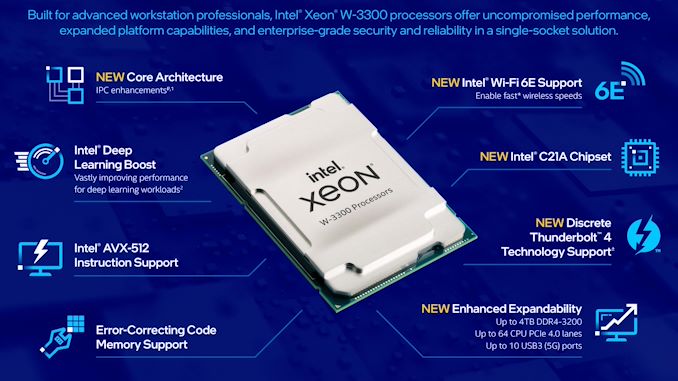
With the launch earlier this year of Intel’s Ice Lake Xeon Scalable platform, the first Intel enterprise platform based on 10nm, we were always wondering to what extent this silicon would penetrate other markets. Today Intel is answering that question by launching the Xeon W-3300 family, using the same Ice Lake Xeon silicon but in a more focused single socket platform. Xeon W-3300 will offer processors from 12 core up to 38 cores, peaking at 270 W TDP, but offering support for up to 4 TB of memory.
The Xeon W-3300 Family
This is the third generation of Intel’s Xeon W processor family, initially highlighted by the overclockable 28-core Xeon W-3175X based on the Skylake family of enterprise CPU architectures. Intel made a big effort with the launch of that processor, and followed it shortly with the Xeon W-3200 series based on Cascade Lake, offering more PCIe lanes and an increase in frequencies. The new Ice Lake Xeon W family uses Intel’s Ice Lake architecture, as we highlighted in our initial Xeon Scalable review of the platform, affording a sizeable gen-on-gen bump performance improvement against the previous Intel processors. In that review we’ve highlighted that Ice Lake offered a good +19% IPC increase, and the gain in core count and TDP provided an uplift despite some regressions in frequency compared to Cascade Lake.
While the Xeon Scalable line offers up to 40 core variants, Xeon W-3300 will go as far as 38 cores, but Intel is focusing mostly on the 32-core version as its lead product. The new Xeon W-3365 with 32 cores is designed to be competitive against AMD’s Threadripper Pro 3975WX, which we recently reviewed, offering the same number of cores, the same DRAM support, and has some tradeoffs.
| Intel Xeon W-3300 Ice Lake SKUs | |||||||
| AnandTech | Cores | Base Freq |
1T Turbo |
nT Turbo |
L3 (MB) |
TDP | Price (1ku) |
| W-3375 | 38 / 76 | 2500 | 4000 | 3300 | 57 | 270 W | $4499 |
| W-3365 | 32 / 64 | 2700 | 4000 | 3500 | 48 | 270 W | $3499 |
| W-3345 | 24 / 48 | 3000 | 4000 | 3700 | 36 | 250 W | $2499 |
| W-3335 | 16 / 32 | 3400 | 4000 | 3700 | 24 | 250 W | $1299 |
| W-3323 | 12 / 24 | 3500 | 3900 | 3700 | 21 | 220 W | $949 |
The top processor is the Xeon W-3375 with 38 cores and 76 threads. The base frequency of 2.5 GHz is offset with a 4.0 GHz single core turbo and a 3.3 GHz all-core turbo, enabled through the 270 W TDP, which increases the TDP of the top Xeon W processor from 255 W in the previous generation.
All the processors will support 64 lanes of PCIe 4.0, 8-channel DDR4-3200 memory (up from 6-channel), and with 256 GB LRDIMMs up to 4 TB per socket (16 modules). The standard Ice Lake enterprise core offers 1.5 MB of L3 cache per core, and for all the processors here that standard stays the same, however the 12-core version uses 1.75 MB of L3 cache per core. Intel has not disclosed the die configurations of the lower core count parts, however the 28+ core parts are almost certainly using the 40 physical core configurations.
These new processors use the same LGA4189 socket as the mainline Xeon Scalable platform, but are enabled through a new generation of C621A chipset which allows for Wi-Fi 6E and Thunderbolt 4 expansion on motherboards should the board OEM built it in. Further information about the C621A has not been detailed at this time.
The other angle new to the Xeon W family is the addition of new instructions for cryptography – Ice Lake cores now support SHA extensions, have doubled AES throughput, and VPMADD52 instruction sets. On top of this, Intel is pushing its latest generation of DLBoost technology to speed up AI workloads through efficient use of the on-board AVX512 units. Although not disclosed, we are under the impression that the Xeon W-3300 parts have dual AVX512 FMAs per core.
Some Xeon W-3365 Benchmarks
Ahead of this launch, we were contacted by a system integrator who shipped us a system that arrived a couple of days ago with the W-3365 installed. Unfortunately the system didn’t survive the transatlantic shipment entirely intact, and we’re still debugging exactly why. But we were able to strip out the board and CPU to do some initial testing. We’re going to be doing a full review hopefully next week.
- Processor: Intel Xeon W-3365 (32-core Ice Lake, 270W)
- Cooler: Noctua NH-U14S LGA4189
- Motherboard: Supermicro X12SPA-TF
- Memory: 8 x 16 GB of DDR4-3200 RDIMM (128 GB)
- Graphics: NVIDIA RTX 3090 FE
- Storage: Intel Optane P5800X 800GB + 2x1 TB Samsung 980 Pro
- Power Supply: 2x Corsair AX860i
- Operating System: Windows 10 20H2
We’re comparing this processor to the 28-core W-3175X and the 32-core TR Pro 3975WX in these initial tests. Intel is targeting this processor very much at workstation-dedicated workflow. Also, the benefit of all these processors listed being 32-core or below means they fit inside Windows’ 64-thread mask limit, which can limit some tests to 64 threads.
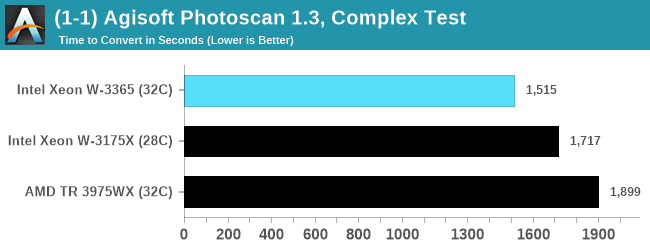
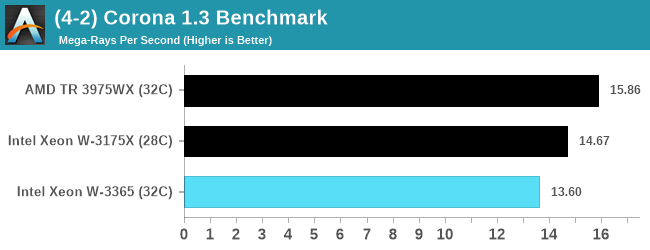
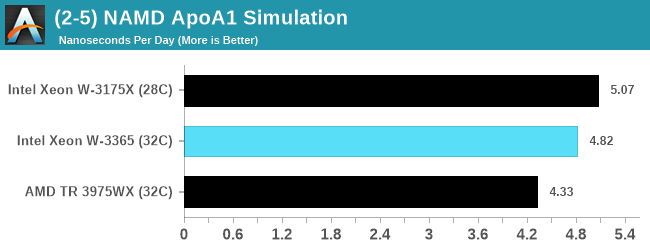
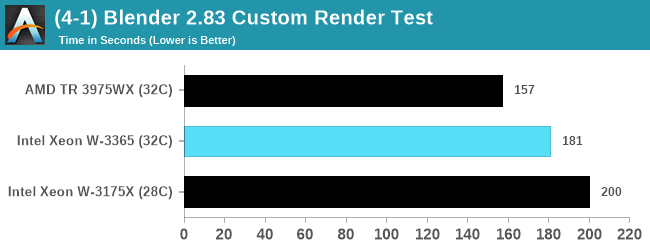
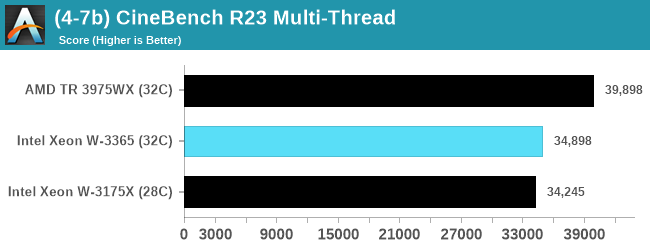
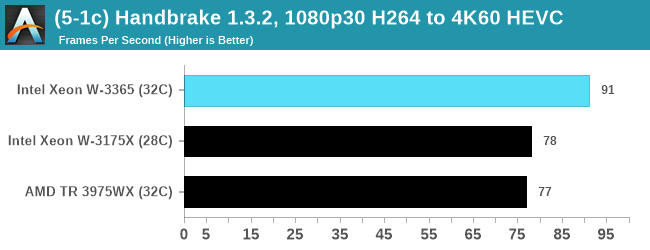
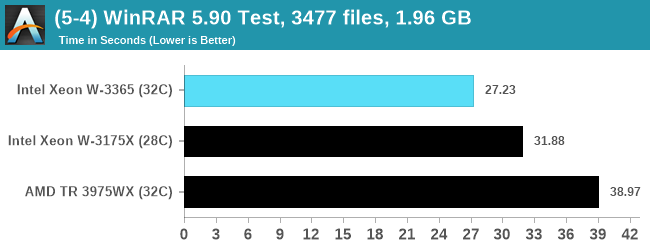
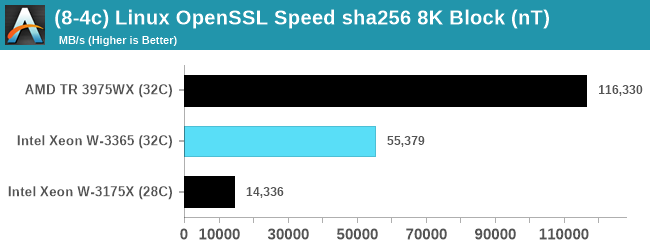
When it comes to power, we're measuring a peak 292 W during AVX-512 workloads and 286 W in AVX2 workloads, however this is preliminary data from a few tests we've been able to run so far.
We can see that the Ice Lake Xeon W-3365 already pushes ahead of the Skylake W-3175X in almost all our benchmark suite, save for a couple of tests that seem to be cache/frequency-dependent. Against the Zen 2-based 3975WX it is more benchmark dependent. We are waiting for AMD to launch its Zen 3-based Threadripper and TR Pro over the next few months.
| Xeon W-3175X vs Xeon W-3365 vs TR Pro 3975WX | |||
| Intel Xeon W-3175X |
Intel Xeon W-3365 |
AnandTech | AMD TR Pro 3975X |
| $2999 | $3499 | Cost | $2750 |
| Skylake Xeon | Ice Lake Xeon | Microarchitecture | Zen 2 |
| 28 / 56 | 32 / 64 | Cores / Threads | 32 / 64 |
| 3100 MHz | 2700 MHz | Base Frequency | 3500 MHz |
| 4300 MHz | 4000 MHz | Turbo Frequency | 4200 MHz |
| 1024 KB | 1280 KB | L2 Cache / core | 512 KB |
| 38.5 MB | 48 MB | L3 Cache | 128 MB |
| 255 W | 270 W | TDP | 280 W |
| 6 x DDR4-2933 | 8 x DDR4-3200 | Memory | 8 x DDR4-3200 |
| 512 GB | 4 TB | Memory Capacity | 4 TB |
| PCIe 3.0 x48 | PCIe 4.0 x64 | PCIe | PCIe 4.0 x128 |
| PCIe 3.0 x4 | PCIe 3.0 x8 | Chipset Link | PCIe 4.0 x8 |
| Yes | Yes | AVX-512 | No |
We’re hoping to put more time into testing this platform, along with the rest of the system sent to us; workstations rarely focus solely on the CPU, and rely very much on the installed graphics, storage, and memory depending on the different bottlenecks of the workload. Stay tuned for that review.










45 Comments
View All Comments
Rudde - Friday, July 30, 2021 - link
I'm surprised that the W-3345 24 core processor is based on the XCC die instead of a 28 core die. The W-3335 and W-3323 on the other hand could just as well be based on a 18 core die. Is Intel saving all good die for servers where power consumption is more strict?Wrs - Friday, July 30, 2021 - link
Probably a clue that 10nm yield is poor. They can't wait to turn a new chapter on process node quality.Spunjji - Friday, July 30, 2021 - link
Almost certainly. They're clearly not getting a lot of good dies...repoman27 - Friday, July 30, 2021 - link
Although Intel was supposedly working on a 16C LCC ICL-SP die, they have yet to release any products based on it, so it was likely scrapped prior to volume production.I'm guessing the 40C die responds better to dumping power into it than the 28C when trying to hit those all-core turbo clocks, and you have 43% more cores to choose from when looking for that golden core that can reach the max single-core turbo. As long as Intel can make their margin, it doesn't matter which die they use. And comparing pricing to the 3rd Gen Xeon Scalable SKUs, they certainly seem to be shooting for that.
JayNor - Friday, July 30, 2021 - link
you're misquoting arc. w-3323 is 12 cores.Oxford Guy - Thursday, July 29, 2021 - link
'Although not disclosed, we are under the impression that the Xeon W-3300 parts have dual AVX512 FMAs per core.'Bizarre that such basic information hasn't been provided.
Sahrin - Thursday, July 29, 2021 - link
Cost is typically no object for a workstation - glad to see AT doing Intel’s marketing department’s work for them in cutting the top AMD SKU’s out of the comparison.mode_13h - Monday, August 2, 2021 - link
> Cost is typically no object for a workstationThat's highly dependent on the use. If the workstation is for running software with licensing costs in the multiple- $10k / year range, then the hardware costs aren't a major consideration.
However, my employer used to buy workstations as the standard (non-laptop) platform for software developers and subsequently switched to mainstream desktops, as workstation costs have climbed.
Also, I built my own socket-2011 workstation that's due for a replacement. I have been priced out of the workstation market, for several years now. Not only CPUs but also motherboards are a lot more expensive than what I'm willing to spend. Fortunately, the capabilities of mainstream desktops have really come up to bridge the gap, mostly thanks to AMD.
flgt - Thursday, July 29, 2021 - link
Intel, only when AMD is out of stock and you have no other options.JayNor - Friday, July 30, 2021 - link
3323 is 12 corehttps://ark.intel.com/content/www/us/en/ark/produc...